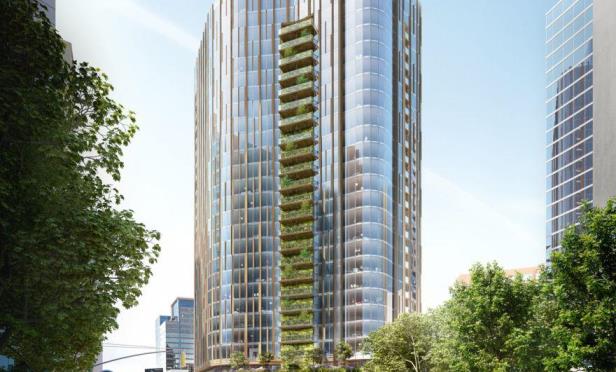 The living wall will be located on Rastegar's 26-story 270-unit condominium development in Dallas.
The living wall will be located on Rastegar's 26-story 270-unit condominium development in Dallas.
DALLAS—Reportedly the tallest living wall in North America is in the works within Rastegar Property Company's 26-story 270-unit condominium development located at 1899 McKinney. The building will improve local air quality with more than 40,000 plants estimated to capture in excess of 1,600 pounds of carbon dioxide and annually produce 1,200 pounds of oxygen.
"This project is very personal to me because I was raised in Dallas, and my wife Kellie and I have always had a dream of being part of the Dallas skyline in a way that enhances quality of life for its residents and the surrounding community," said Ari Rastegar, founder and chief executive officer of Rastegar Property Company. "Our shared vision and objective behind this project will bring something new to the Dallas real estate scene that will positively impact the community, increase walkability and bring more green space to the corridor."
The 1899 McKinney development is located across the street from The Union mixed-use complex that sold for a record-breaking $370 million in February 2020. The soon-to-be-demolished structure on the current site was previously occupied by a building that housed an office furniture showroom and a nightclub.
"We thought about how living walls can positively influence the city of Dallas," said Zach Smith, CEO of Zauben, a Chicago-based living wall company. "We wanted to help champion the sustainability goals of the city and create an example that other forward-thinking cities can follow. Rastegar is offering a fresh perspective on how developers can grapple with some of the most urgent environmental issues, including air quality and carbon emissions."
The building was designed by Chicago-based architect Solomon Cordwell Buenz. Plans show a contoured glass tower with heavily landscaped balconies. There is also a pocket park that will be maintained by Rastegar on McKinney Avenue and the building's parking will be a wholly underground garage.
"The living wall is located on a balcony that is part of a leased unit," Josh Eadie, vice president of real estate at Rastegar Property Company, tells GlobeSt.com. "We have four sets of balconies for select units, typical to high-rise multifamily buildings, and these living walls are on the north and south balconies."
Eadie says the wall is still in the design phase so operation and maintenance specifics have not been entirely determined.
"The living wall system can operate in a number of ways, but given that we are currently still in the design phase of the project, we fully anticipate the building design to include a watering system for the living wall," Eadie tells GlobeSt.com. "This is accomplished through plumbed-in drip lines and is not connected to a fire-life safety system such as our sprinkler system. Think of it as landscape irrigation, making the plants self-watering."
Property management will be responsible for the maintenance of the living wall, although Rastegar anticipates residents will develop a vested interest and may take an interest in tending for the plants.
"The average expected life span of the plants is 10 to 15 years, with minimal replacement being common after the plants adapt from their greenhouses to the project install," Eadie tells GlobeSt.com. "After the first year of monitoring, maintenance is low; involving simple pruning and care that is in line with your average house or balcony plants."
Rastegar welcomed Kristaps Porzingis of the Dallas Mavericks and his family as partners in the project. "We are committed to the long-term health and economic growth of the Dallas community and are thrilled to support the concept of the living wall," said Martins Porzingis. "Our partnership with Rastegar facilitates our interest in high-growth areas within the cities we care about, and shining a spotlight on sustainability efforts to make our communities cleaner and better places to live."
A study out of the University of Hyogo in Awaji, Japan explored the practical use of indoor plants to boost mental health among employees typically removed from exposure to healthy green environments. The research details the stress-reducing benefits to office workers that even a small plant situated within easy viewing can impart. The findings were published in the open access journal HortTechnology by the American Society for Horticultural Science.
© Touchpoint Markets, All Rights Reserved. Request academic re-use from www.copyright.com. All other uses, submit a request to [email protected]. For more inforrmation visit Asset & Logo Licensing.







